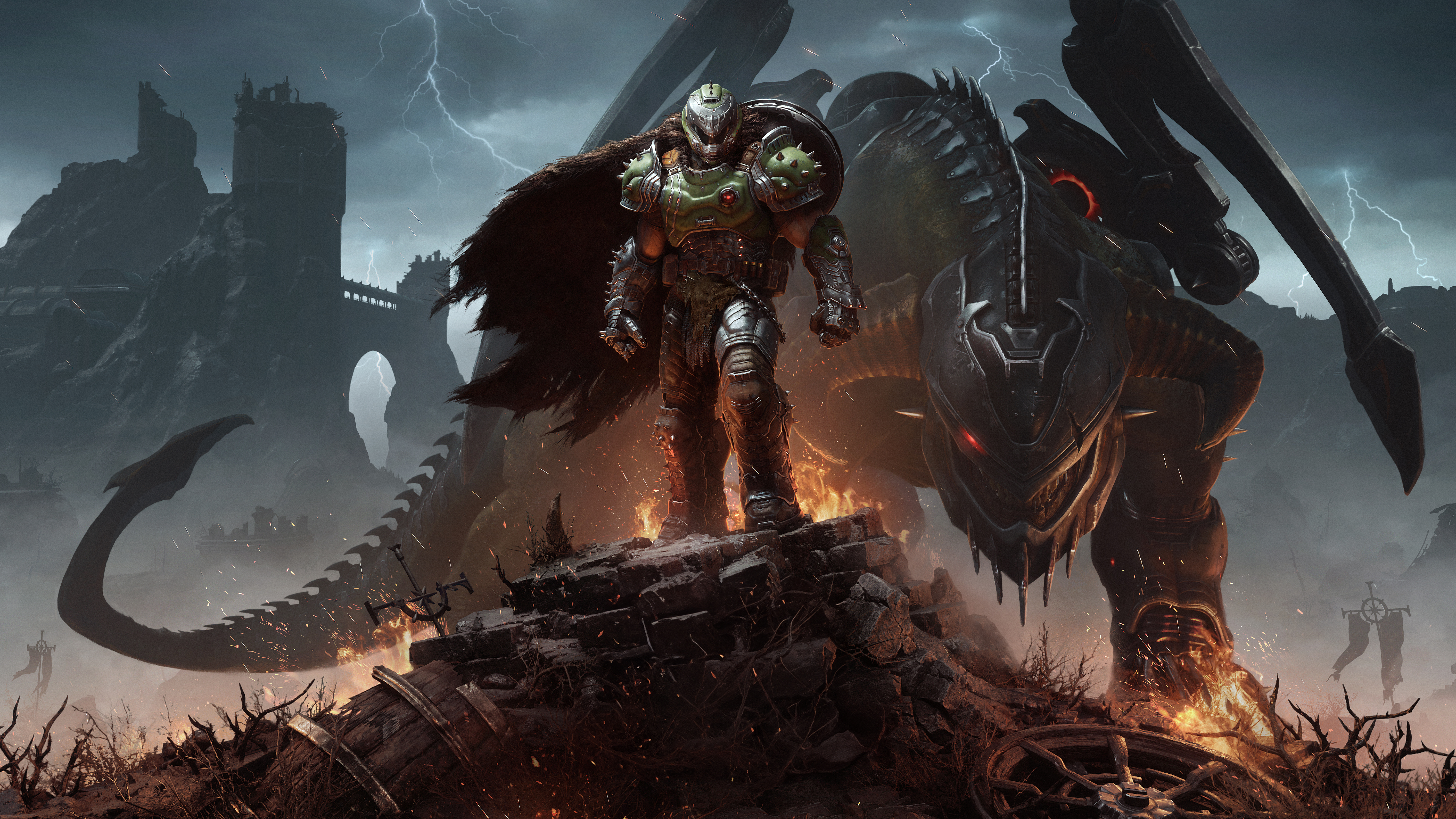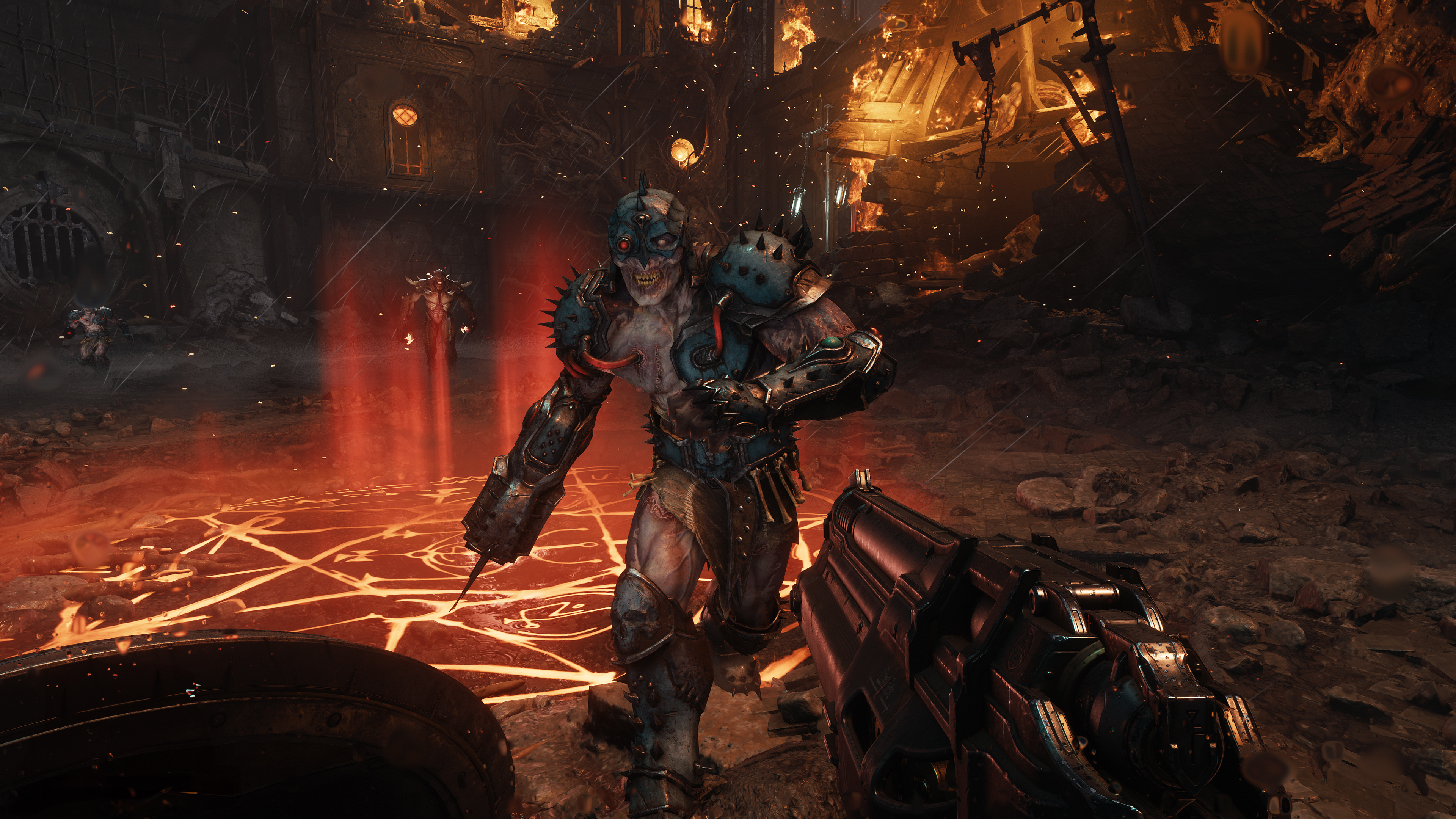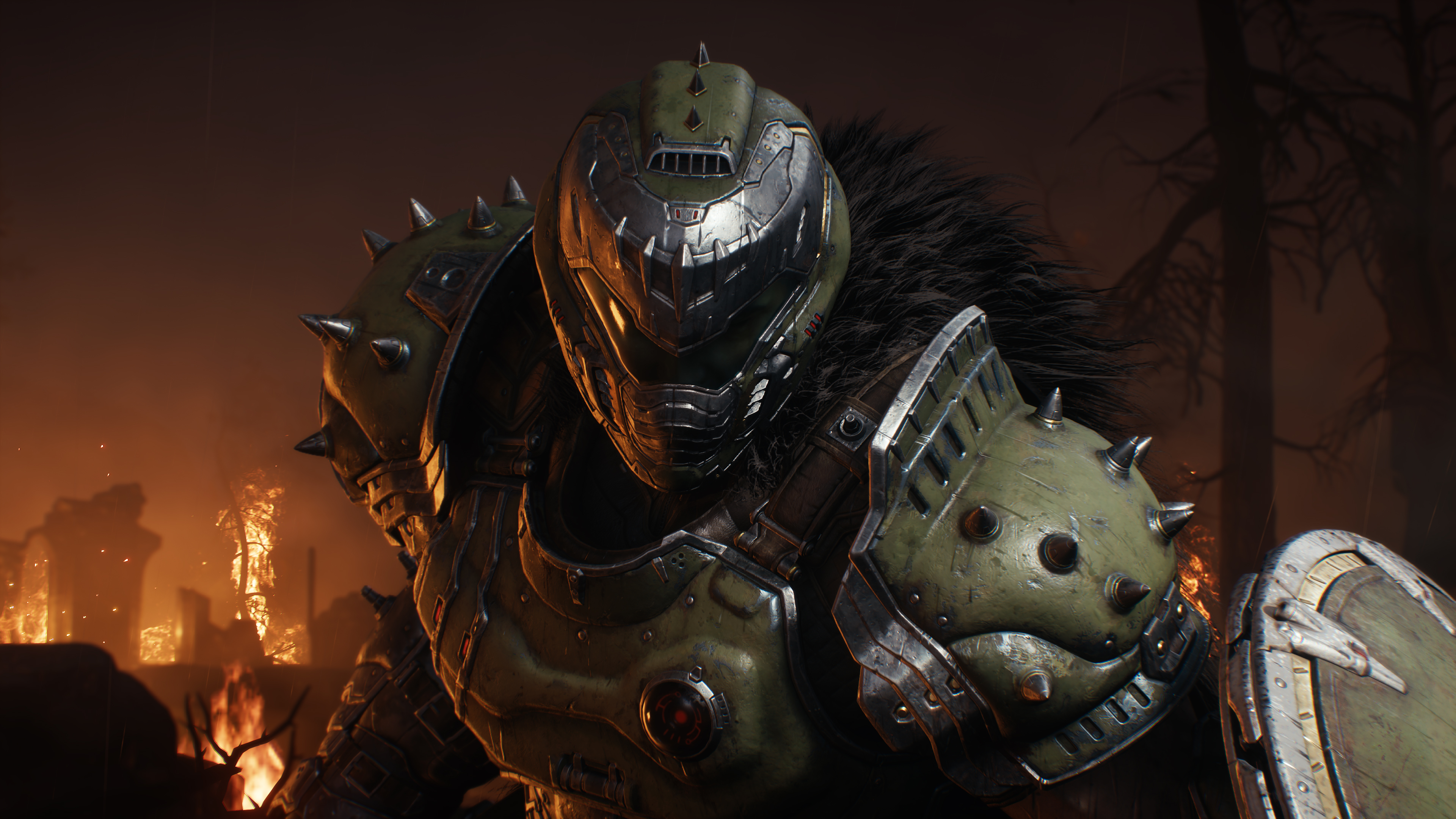Our Verdict
Brilliantly rethinks run-and-gun gameplay for the 2020s, enabled by thoroughly modern visuals. Doom: The Dark Ages is an object lesson into how to modernise an old classic.
For
- A visual masterclass
- Gameplay is familiar yet with added depth
- Hugely replayable
Against
- Story dialogue is clunky
- Dragon and mechs aren't as compelling as core gameplay
Why you can trust Creative Bloq

Publisher Bethesda
Developer id Software
Release date 15 May
Format Xbox Series X/S, PC, PS5 (reviewed)
Platform idTech 8
With Doom: The Dark Ages id Software needed to once again redesign its iconic gaming brand. Now over 30 years old, id Software’s Doom franchise is one of the games industry’s equivalents of a national treasure (Doom has even been remade by AI). Which brings pressure and responsibility: Doom is synonymous with run-and-gun gameplay, but can that be updated for the modern world?
Id Software made one attempt to do just that with 2020’s Doom Eternal, but with Doom: The Dark Ages, it feels as though it has properly cracked the conundrum, producing something which feels unmistakably, essentially Doom, yet also thoroughly up-to-the-minute. It has been so cleverly revamped that it makes Doom Eternal resemble an anomalous rehearsal.

Doom has utterly modern visuals
A big part of Doom: The Dark Ages updating, of course, lies in its graphics, crafted using the developer’s own proprietary Idtech 8 engine. A game engine which, graphically speaking, was created with Doom in mind.
Jump into Doom: The Dark Ages and you are greeted with a colour palette that hasn’t changed since the first game was released in 1993: all browns, blacks and dull metal, studded with glowing green, red and orange pick-ups, similarly coloured projectile attacks and of course lava galore – even the more lush, vegetated outdoor sequences have a slightly muted colour balance, to allow those crucial glowing pick-ups to stand out.

The Idtech engine may be able to trace its origins back 30 years, but its eighth iteration is very much among the best in the industry, which has allowed id Software to provide the venerable game with a visual makeover that feels thoroughly modern.
That gothic, heavy metal album cover vibe still pervades, but those classic demon enemies, recreated in high-resolution, get to the heart of Doom: The Dark Ages’ appeal by looking at the same time familiar yet vastly more detailed.
Where once, many of them had a slightly comic air (at least until they started pulverizing you), they now all look appropriately intimidating. Texturally, they’re great, too: even when pixelated, they often had a squishy feel to them, but in Doom: The Dark Ages, that aspect has been ramped up to the nth degree.
Daily design news, reviews, how-tos and more, as picked by the editors.

That even plays into the gameplay – for example, some demons have metal shields which, if shot, start to superheat and glow. When I spotted that happening, it provided a trigger to chuck my Doom Slayer’s shield at them, causing them to explode.
Other demons have plasma shields, which will similarly explode (taking out nearby demons in the process) when shot with one of the two plasma guns. There’s so much going on on Doom: The Dark Ages’ battlefields (I generally found myself facing hundreds of enemies at any given point, of such a bewildering number of varieties that they had to be approached in a strategic manner) that it simply wouldn’t play anything like as well if it didn’t look absolutely spot-on.

Brilliantly revamped gameplay
If its impressively up-to-the-minute visuals are a key enabler, Doom: The Dark Ages’ core brilliance lies in the way in which id Software has taken that signature run-and-gun gameplay and expanded it into something that, while still familiar, also manages to feel fresh and new. The developer has put in some deep and very effective thought into how to redefine run-and-gun for the 2020s, and the results are simply exemplary.
I’ve always loved playing as the Doom Slayer, but this time around, he has more demon-pulverising tools than ever at his command. In his left hand is the newest one: a shield with what is essentially a chainsaw running around its rim. It’s insanely versatile: I could chuck it to take out remote enemies, or perform a shield-bash which drew me instantly to far-off enemies, taking them out in the process. I could also embed it in any green goo visible in the environment then launch myself towards that, so effectively, it doubled as a grapple. Plus, in typical shield style, I could use it to counter nearby attacks and bat incoming projectile attacks (usually slow-moving, in typical Doom style) back at whoever unleashed them.

Another new and important gameplay mechanic – seen in a much more speculative form in Doom Eternal – is melee attacks which are impressively devastating, particularly when I found myself in a tight spot. There are three to choose between, a basic gauntlet one, a wide-area mace one and the Dreadmace. The latter takes an age to recharge; the wide-area mace was definitely my favourite. I could also charge it by finding ammo-style pick-ups and unleash a sequence of three attacks.
Like everything in Doom: The Dark Ages (including all the weapons and the rune-based effects that come into play when parrying incoming projectiles), each melee attack has its own upgrade path. To upgrade the Doom Slayer’s innate stats (including maximum health and armour, plus the amount of ammo each gun can carry), I had to take out specific enemies called Leaders, which have buffed stats but which yield Demonic Essence when defeated.
Id Software has added depth to the gameplay via creating other enhanced versions of the demons, including Enforcers, which summon hordes of minions until you take them out, and Morale Encounters, featuring major demons that are shielded until you have reduced a morale meter to zero by taking out hundreds of the surrounding demons.

Dragons and mechs
To add variety to the gameplay, id Software has given the Doom Slayer two giant mechs to control: a dragon and a variety of Atlans – giant human mechs. I found them to be a partial success – they certainly add an element of respite from the relentlessly full-on nature of the core gameplay.
The dragon has an interesting mechanism that involves locking onto to targets and powering up its guns by executing perfect dodges, and the Atlan starts off melee-based but eventually gets a weapon. Both elements at least add a welcome sense of ebb and flow to the gameplay.
There’s environmental puzzling too, usually involving the shield, some of which is quite inventive. And there’s a vast amount of replayability: Doom: The Dark Ages is split into 22 chapters, and at the end of each, I was told what percentage of its contents I had found.
Even before finishing the first playthrough, I had gone back to early chapters in search of the coloured keys that open up hidden areas, usually stocked with the gold and rubies that can be cashed in at shrines for upgrades.

Doom: The Dark Ages also has a prominent storyline: it’s a prequel to the original Doom timeline-wise. But the story is its least successful aspect. The cut-scenes look pretty decent, but the dialogue is pompous, clunky and lacking humour, and the interplay between the three factions – the Sentinels, the Makyrs and the denizens of hell – are often rather confusing.
Whereas the original Doom – by necessity, given when it was released – was a simple game, Doom: The Dark Ages is anything but, possessing many layers and depths in both its innate gameplay and its underlying structure. So it’s a bit of a miracle that Doom: The Dark Ages manages to be utterly coherent, and to still feel as though it possesses that irresistible Doom essence (a reminder, Doom is one of the best games of the 90s, so we've come a long way).

But Doom: The Dark Ages does manage to retain what has always made the series so good – which isn’t something I would say about Doom Eternal, eminently playable though that game was. But Doom: The Dark Ages is vastly better than its most recent predecessor. It achieves its difficult aim of taking the Doom blueprint into the 2020s and as such, offers the prospect of a new Doom era.
Another indication of how id Software’s priority has been to concentrate on the core elements of the game is that, at launch, Doom: The Dark Ages is single-player only. But I reckon that it’s highly likely that it will soon acquire some multiplayer modes via DLC. Until then, it’s more than enough to simply marvel at how id Software has managed to reinvent such an ancient franchise in such a modern manner.
out of 10
Brilliantly rethinks run-and-gun gameplay for the 2020s, enabled by thoroughly modern visuals. Doom: The Dark Ages is an object lesson into how to modernise an old classic.
Steve has written about video games since the early 1990s. Nowadays, he also writes for The Guardian, Pocket-lint, VGC and Metro; past outlets include Edge, The Daily Telegraph, The Sunday Times, The Mirror, The Face, C&VG, Esquire and sleazenation.
You must confirm your public display name before commenting
Please logout and then login again, you will then be prompted to enter your display name.

